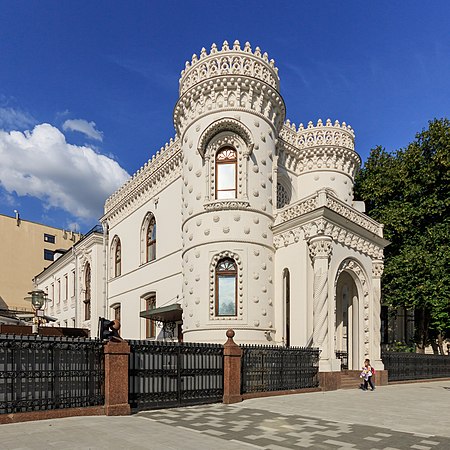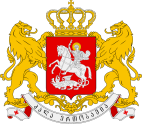Kingdom of Kakheti
| ||||||||||||||||||||||||||||||||||||||||||||||||||||||||||||||||
Read other articles:

Nazareno Fabbretti Nazareno Fabbretti (Iano, 1º gennaio 1920 – Salice Terme, 25 ottobre 1997) è stato un giornalista, presbitero e francescano italiano, membro dell'Ordine dei Frati Minori. Insieme a figure come don Primo Mazzolari, don Milani, padre Davide Turoldo e padre Ernesto Balducci può essere considerato un precursore del Concilio Vaticano II[1]. Indice 1 Biografia 2 La Sala Frate Sole 3 Scrittore 4 Giornalista 5 Note 6 Opere 7 Bibliografia 8 Altri progetti 9 Collegamenti es…

Bus station in Mirrabooka, Australia Mirrabooka bus stationGeneral informationLocationChesterfield Road, MirrabookaWestern AustraliaAustraliaCoordinates31°52′12″S 115°51′31″E / 31.870°S 115.8585°E / -31.870; 115.8585Owned byPublic Transport AuthorityOperated byTransperthBus routes14Bus stands12Other informationFare zone2HistoryOpened1970sRebuilt13 December 2010 Mirrabooka bus station is a Transperth bus station in Mirrabooka approximately 12 kilometres north o…

County in Ohio, United States Not to be confused with Montgomery, Ohio. County in OhioMontgomery CountyCountyCurrent Montgomery County Courthouse SealLocation within the U.S. state of OhioOhio's location within the U.S.Coordinates: 39°45′N 84°17′W / 39.75°N 84.29°W / 39.75; -84.29Country United StatesState OhioFoundedMay 1, 1803[1]Named forRichard MontgomerySeatDaytonLargest cityDaytonArea • Total464 sq mi (1,200 km2)&#…

Федеральное агентство по делам Содружества Независимых Государств, соотечественников, проживающих за рубежом, и по международному гуманитарному сотрудничествусокращённо: Россотрудничество Общая информация Страна Россия Юрисдикция Россия Дата создания 6 сентября 20…

此條目需要补充更多来源。 (2021年7月4日)请协助補充多方面可靠来源以改善这篇条目,无法查证的内容可能會因為异议提出而被移除。致使用者:请搜索一下条目的标题(来源搜索:美国众议院 — 网页、新闻、书籍、学术、图像),以检查网络上是否存在该主题的更多可靠来源(判定指引)。 美國眾議院 United States House of Representatives第118届美国国会众议院徽章 众议院旗帜…
2020年夏季奥林匹克运动会波兰代表團波兰国旗IOC編碼POLNOC波蘭奧林匹克委員會網站olimpijski.pl(英文)(波兰文)2020年夏季奥林匹克运动会(東京)2021年7月23日至8月8日(受2019冠状病毒病疫情影响推迟,但仍保留原定名称)運動員206參賽項目24个大项旗手开幕式:帕维尔·科热尼奥夫斯基(游泳)和马娅·沃什乔夫斯卡(自行车)[1]闭幕式:卡罗利娜·纳亚(皮划艇)[2…

Regol Donopratopo Keraton Ngayogyakarta Hadiningrat tampak dari depan Keraton Yogyakarta terletak di tengah kota Yogyakarta, memiliki beberapa museum, yaitu Museum Lukisan, Museum Sri Sultan Hamengkubuwono IX, Museum Kereta, dan Museum Batik. Di samping itu, hampir seluruh bagian kraton digunakan sebagai tempat penyimpanan benda-benda budaya bernilai, termasuk replikanya. Di kompleks Pagelaran, misalnya, diperagakan berbagai pakaian prajurit dan pakaian adat keluarga keraton. Museum ini dibuka u…

Військово-музичне управління Збройних сил України Тип військове формуванняЗасновано 1992Країна Україна Емблема управління Військово-музичне управління Збройних сил України — структурний підрозділ Генерального штабу Збройних сил України призначений для плануван�…

Командування повітряно-космічної оборони Північної АмерикиNorth American Aerospace Defense Command Емблема НОРАДНа службі з 12 травня 1958 року — сьогоденняКраїна США/ КанадаВид повітряні силиТип КомандуванняРоль протиповітряна оборона, контроль навколоземного космічного просторуУ …

Public college in Augusta, ME This article is about the University of Maine at Augusta. For the flagship campus in Orono, see University of Maine. University of Maine at AugustaTypePublic collegeEstablished1965; 59 years ago (1965)Parent institutionUniversity of Maine SystemPresidentJenifer CushmanStudents6,000LocationAugusta, Maine, United States44°20′18″N 69°47′50″W / 44.33833°N 69.79722°W / 44.33833; -69.79722CampusUrbanColors Navy &…

1979 Tháng 1 Tháng 2 Tháng 3 Tháng 4 Tháng 5 Tháng 6 Tháng 7 Tháng 8 Tháng 9 Tháng 10 Tháng 11 Tháng 12 Năm lịchBản mẫu:SHORTDESC:Năm lịch Thiên niên kỷ: thiên niên kỷ 2 Thế kỷ: thế kỷ 19 thế kỷ 20 thế kỷ 21 Thập niên: thập niên 1950 thập niên 1960 thập niên 1970 thập niên 1980 thập niên 1990 Năm: 1976 1977 1978 1979 1980 1981 1982 1979 trong lịch khácLịch Gregory1979MCMLX…

Стиль этой статьи неэнциклопедичен или нарушает нормы литературного русского языка. Статью следует исправить согласно стилистическим правилам Википедии. В статье не хватает ссылок на источники (см. рекомендации по поиску). Информация должна быть проверяема, иначе она мо�…

Daerah ini tidak sama dengan Albania di Eropa tenggara. Negara kuno Kaukasus: Armenia, Iberia, Colchis dan Albania Albania Kaukasia, juga disebut Alvank dalam bahasa Armenia,[1][2] Ardhan dalam bahasa Parthia, Arran dalam bahasa Persia,[3] dan Al-Ran dalam bahasa Arab,[1][3] adalah kerajaan kuno yang terletak di daerah Republik Azerbaijan dan Dagestan selatan modern. Nama Albania adalah nama dalam bahasa Latin, dan istilah untuk tanah bergunung-gunung.[…

British peer and politician (born 1945) His GraceThe Duke of WellingtonGE OBE DLWellington in 2015Member of the House of LordsLord Temporalas an elected hereditary peer 17 September 2015By-election17 September 2015Preceded byThe 3rd Baron LukeMember of the European Parliamentfor Surrey WestSurrey (1979–1984)In office1979–1989Preceded byConstituency establishedSucceeded byTom Spencer Personal detailsBornArthur Charles Valerian Wellesley (1945-08-19) 19 August 1945 (age 78)H.R.H. Prin…

此條目需要擴充。 (2015年4月2日)请協助改善这篇條目,更進一步的信息可能會在討論頁或扩充请求中找到。请在擴充條目後將此模板移除。 此條目没有列出任何参考或来源。 (2015年4月2日)維基百科所有的內容都應該可供查證。请协助補充可靠来源以改善这篇条目。无法查证的內容可能會因為異議提出而被移除。 格拉納達邦聯Confederación Granadina1858年—1863年 国旗 国徽 格言:西�…

Railway station in Ontario, Canada BrantfordGeneral informationLocation5 Wadsworth St., Brantford, OntarioCanadaCoordinates43°08′48″N 80°15′56″W / 43.14667°N 80.26556°W / 43.14667; -80.26556Owned byVia RailPlatforms1 side platform, 1 island platformTracks2ConstructionParkingYesAccessibleYesOther informationStatusStaffed stationHistoryOpened1905Rebuilt2002Services Preceding station Via Rail Following station Woodstocktoward Windsor Windsor–Toronto Aldershotto…

Questa voce o sezione sugli argomenti attori italiani e doppiatori italiani non cita le fonti necessarie o quelle presenti sono insufficienti. Puoi migliorare questa voce aggiungendo citazioni da fonti attendibili secondo le linee guida sull'uso delle fonti. Segui i suggerimenti del progetto di riferimento. Rita Savagnone nel 1973 Rita Savagnone (Roma, 19 settembre 1939) è un'attrice, doppiatrice e direttrice del doppiaggio italiana. Indice 1 Biografia 2 Vita privata 3 Doppiaggio 3.1 Cinem…

Castello di SchönbrunnIl Castello di Schönbrunn dal parco nel 2014.LocalizzazioneStato Austria LocalitàVienna IndirizzoSchönbrunner Schloßstraße 47 Coordinate48°11′04.26″N 16°18′42.71″E48°11′04.26″N, 16°18′42.71″E Informazioni generaliCondizioniIn uso Costruzione1696 - 1780 Stilebarocco e barocco RealizzazioneArchitettoJohann Bernhard Fischer von ErlachNicolò Pacassi ProprietarioLeopoldo I d'Asburgo CommittenteLeopoldo I Modifica dati su Wikidata · Manuale &…

Enrico Caetanicardinale di Santa Romana ChiesaRitratto del cardinale Caetani. Incarichi ricoperti Patriarca titolare di Alessandria dei Latini (1585) Cardinale presbitero di Santa Pudenziana(1586-1599) Legato apostolico di Bologna (1585-1587) Camerlengo di Santa Romana Chiesa (1587-1599) Nato6 agosto 1550 a Sermoneta Ordinato presbiteroin data sconosciuta Nominato patriarca29 luglio 1585 da papa Sisto V Consacrato patriarca11 agosto 1585 dal cardinale Giulio Antonio Santori Creato ca…

Dan FeeneyFeeney nel 2017Nazionalità Stati Uniti Altezza193 cm Peso141 kg Football americano RuoloOffensive guard Squadra New York Jets CarrieraGiovanili 2013-2016 Indiana Hoosiers Squadre di club 2017-2020 Los Angeles Chargers2021- New York Jets StatistichePartite15 Partite da titolare9 Statistiche aggiornate al 18 gennaio 2018 Modifica dati su Wikidata · Manuale Daniel Feeney (Orland Park, 29 maggio 1994) è un giocatore di football americano statunitense ch…








